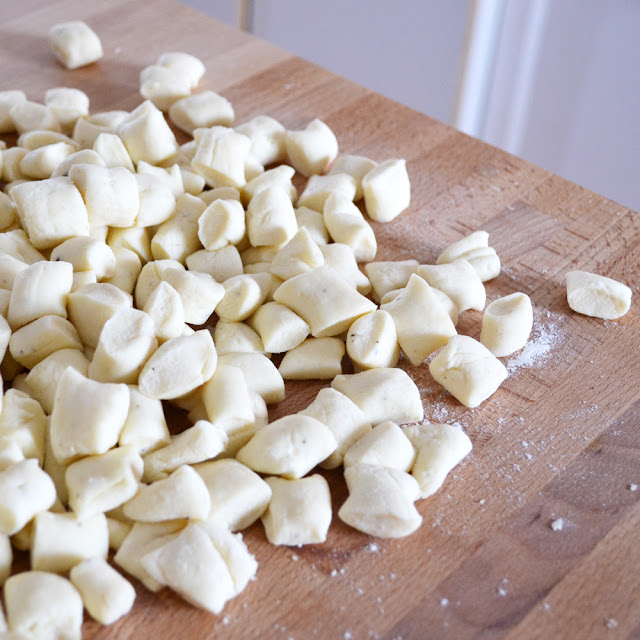 Each region of Italy has its own pasta shapes and pasta recipes. Valeggio sul Mincio, a town near Lago di Garda and the city of Verona, is famous for its Tortellini di Valeggio, tortellini made of pasta as thin as a veil with a filling of beef, chicken, and pork. To make them extra delicate, the pasta dough is made with part of the eggs replaced by water.
Each region of Italy has its own pasta shapes and pasta recipes. Valeggio sul Mincio, a town near Lago di Garda and the city of Verona, is famous for its Tortellini di Valeggio, tortellini made of pasta as thin as a veil with a filling of beef, chicken, and pork. To make them extra delicate, the pasta dough is made with part of the eggs replaced by water.
The tortellini are cooked in a meat stock. You could also serve them in the stock, or with butter and sage like I did. You can then use the leftover stock to make risotto. This does mean that you can’t use as much salt in the stock as you would for cooking the tortellini in water, so in this case it is a good idea to add salt to the pasta dough. For additional flavor, I made the filling with fat from the stock (that floats on top) instead of olive oil.
For the filling
100 grams (3.5 oz) boneless and skinless chicken thigh, cubed
100 grams (3.5 oz) pork shoulder, cubed
100 grams (3.5 oz) stewing beef, such as chuck, cubed
50 grams (1.75 oz) prosciutto, cut into strips
50 grams (1.75 oz) freshly grated parmigiano reggiano
25 grams (1 oz) stale bread, cubed
1 clove
80 ml (1/3 cup) Bardolino (red wine)
salt and freshly ground black pepper
1 egg yolk
1/2 Tbsp rosemary needles
dash of freshly grated nutmeg
1/2 onion, minced
2 Tbsp olive oil (or substitute with the fat from making the stock)
For the pasta dough
 2 eggs
2 eggs
300 grams (2 cups) Italian 00 flour
about 50 ml (1/4 cup) water
For cooking and serving
2 litres (2 quarts) meat stock (made from chicken, beef, and pork)
50 grams (4 Tbsp) butter
2 Tbsp chopped fresh sage
freshly grated parmigiano reggiano
Heat the olive oil (or fat from stock) in a casserole. Add the onion and sauté over medium heat until the onion is translucent.
Add the pork, chicken, and beef, and sauté over medium high heat until the meat has lost its raw color on all sides. Add the rosemary.
Deglaze with the Bardolino.
Scrape with a wooden spatula to include the browned bits into the sauce.Add the clove, nutmeg, and season with salt and pepper.Cover and reduce the heat to low.Allow to simmer over low heat until the meat is tender, about 1 hour. Add a bit of meat stock if it becomes too dry.At the end of the cooking time (it is not very important that the meat is tender, as it will be ground anyway), remove the clove.Transfer the contents of the casserole to the food processor, including all the juices. Allow to cool somewhat (so the egg yolk won’t be cooked when you add it).Add the prosciutto, bread, and egg yolk as well as the cheese.Process with the ‘pulse’ until the mixture is homogeneous, but not pureed. It is nice to have some texture. Taste and adjust the seasoning with salt and freshly ground black pepper. Remember that the filling of tortellini and ravioli should always be slightly over-seasoned to avoid that your tortellini will end up tasting bland.Transfer the filling to a bowl, cover with plastic wrap, and refrigerate for an hour to firm up.Make pasta dough and roll it out as thinly as you can. Cut the pasta dough into 5 cm (2 inch) squares, and put a small ball of filling (about 1/2 teaspoon) on each square.Fold each square into a triangle, and seal the edges without trapping any air inside.Fold the tortellini around your finger, then fold it backwards. (That last step is not really needed.)
Arrange the tortellini on a surface sprinkled with semolina flour in a single layer.
To cook, bring the stock to a boil. Melt the butter in a non-stick frying pan and add the sage. When the stock boils, add the tortellini and cook them for a couple of minutes (depending on how much you dried them).
Transfer them to the butter and sage with a slotted spoon.Toss the tortellini in the butter and sage to coat them on all sides.
Serve on preheated plates, sprinkled with freshly grated Parmigiano.
Wine pairing
This is great with a Bardolino, the local red wine that is also used to make the filling. Bardolino is a light red wine that is best when slightly chilled (15ºC/59ºF
 Meanwhile, heat the milk in a separate pan until just about to boil. Add the hot milk to the butter mixture 1 cup at a time, whisking continuously until very smooth. Bring to a boil. Cook 10 minutes, stirring constantly, then remove from heat. Add the cream and cheeses. Season with salt and nutmeg, and set aside until ready to use. In a different pan, toast the almonds with olive oil or butter and add to the sauce.
Meanwhile, heat the milk in a separate pan until just about to boil. Add the hot milk to the butter mixture 1 cup at a time, whisking continuously until very smooth. Bring to a boil. Cook 10 minutes, stirring constantly, then remove from heat. Add the cream and cheeses. Season with salt and nutmeg, and set aside until ready to use. In a different pan, toast the almonds with olive oil or butter and add to the sauce.





















